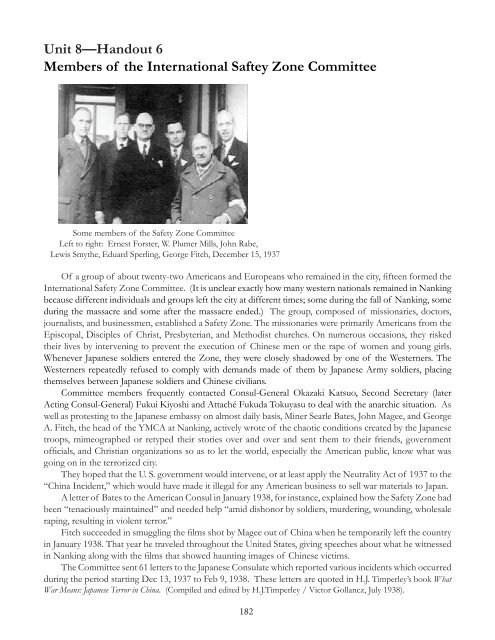Download - Canada ALPHA
Download - Canada ALPHA
Download - Canada ALPHA
Create successful ePaper yourself
Turn your PDF publications into a flip-book with our unique Google optimized e-Paper software.
Unit 8—Handout 6<br />
Members of the International Saftey Zone Committee<br />
Some members of the Safety Zone Committee<br />
Left to right: Ernest Forster, W. Plumer Mills, John Rabe,<br />
Lewis Smythe, Eduard Sperling, George Fitch, December 15, 1937<br />
Of a group of about twenty-two Americans and Europeans who remained in the city, fi fteen formed the<br />
International Safety Zone Committee. (It is unclear exactly how many western nationals remained in Nanking<br />
because different individuals and groups left the city at different times; some during the fall of Nanking, some<br />
during the massacre and some after the massacre ended.) The group, composed of missionaries, doctors,<br />
journalists, and businessmen, established a Safety Zone. The missionaries were primarily Americans from the<br />
Episcopal, Disciples of Christ, Presbyterian, and Methodist churches. On numerous occasions, they risked<br />
their lives by intervening to prevent the execution of Chinese men or the rape of women and young girls.<br />
Whenever Japanese soldiers entered the Zone, they were closely shadowed by one of the Westerners. The<br />
Westerners repeatedly refused to comply with demands made of them by Japanese Army soldiers, placing<br />
themselves between Japanese soldiers and Chinese civilians.<br />
Committee members frequently contacted Consul-General Okazaki Katsuo, Second Secretary (later<br />
Acting Consul-General) Fukui Kiyoshi and Attaché Fukuda Tokuyasu to deal with the anarchic situation. As<br />
well as protesting to the Japanese embassy on almost daily basis, Miner Searle Bates, John Magee, and George<br />
A. Fitch, the head of the YMCA at Nanking, actively wrote of the chaotic conditions created by the Japanese<br />
troops, mimeographed or retyped their stories over and over and sent them to their friends, government<br />
offi cials, and Christian organizations so as to let the world, especially the American public, know what was<br />
going on in the terrorized city.<br />
They hoped that the U. S. government would intervene, or at least apply the Neutrality Act of 1937 to the<br />
“China Incident,” which would have made it illegal for any American business to sell war materials to Japan.<br />
A letter of Bates to the American Consul in January 1938, for instance, explained how the Safety Zone had<br />
been “tenaciously maintained” and needed help “amid dishonor by soldiers, murdering, wounding, wholesale<br />
raping, resulting in violent terror.”<br />
Fitch succeeded in smuggling the fi lms shot by Magee out of China when he temporarily left the country<br />
in January 1938. That year he traveled throughout the United States, giving speeches about what he witnessed<br />
in Nanking along with the fi lms that showed haunting images of Chinese victims.<br />
The Committee sent 61 letters to the Japanese Consulate which reported various incidents which occurred<br />
during the period starting Dec 13, 1937 to Feb 9, 1938. These letters are quoted in H.J. Timperley’s book What<br />
War Means: Japanese Terror in China. (Compiled and edited by H.J.Timperley / Victor Gollancz, July 1938).<br />
182


